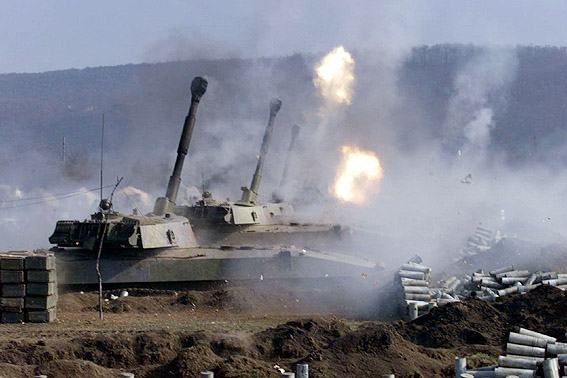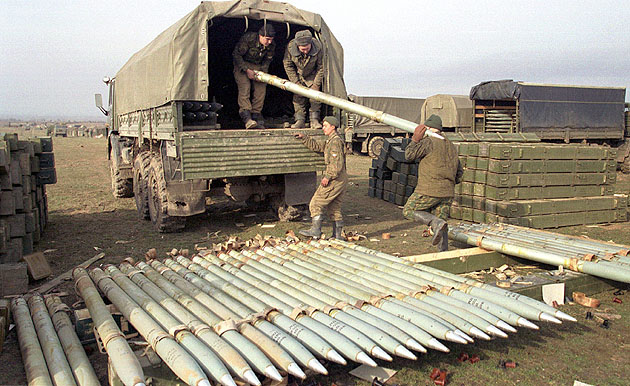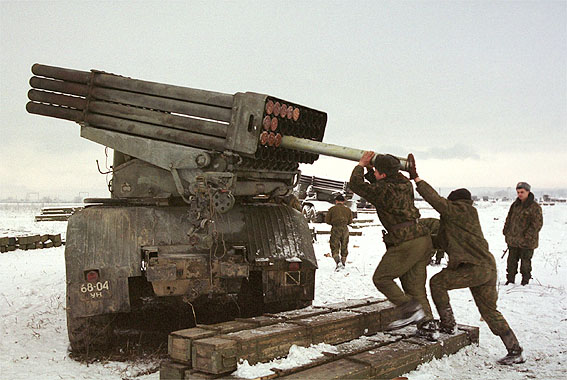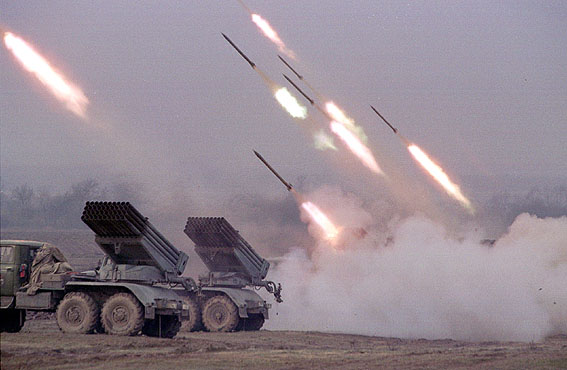
Posted on 11/06/2002 11:51:21 PM PST by VaBthang4
Terminal Accuracy
Smart Munitions Knock Out Ground Targets With Fewer Weapons, Less Collateral Damage Glenn W. Goodman, Jr.
The extensive use of satellite-guided, Joint Direct Attack Munitions (JDAMs) by US Navy and Air Force aircraft to destroy high-value ground targets during Operation Enduring Freedom in Afghanistan marked another progression in the application of US airpower.
During the 1999 Kosovo air campaign, the bulk of the precision-guided munitions (PGMs) used were laser-guided bombs, which had been the air-to-surface weapon of choice for US air strikes for 20 years. JDAMs were still in low-rate initial production by Boeing, and USAF's B-2 stealth bomber was the only aircraft certified to drop them. (B-2s dropped 656 JDAMs during Operation Allied Force in the weapon's first operational use, putting 90 percent of the bombs within 12 meters of their aimpoints, and damaging or destroying 87 percent of the targets, despite poor visibility.)
But JDAMs came to the fore in Operation Enduring Freedom due to their effectiveness. During the first two months of the strikes on al Qaeda and Taliban targets in Afghanistan last fall, 4,600 of the 7,200 air-delivered PGMs expended were JDAMs, while the rest were laser-guided bombs and Tomahawk cruise missiles.
Both laser-guided bombs and JDAMs use a strap-on guidance and tail fin kit to make near-precision "smart" weapons out of standard Air Force/Navy 500-, 1,000-, and 2,000-pound, free-fall "dumb" bombs, including special penetrator bombs in those categories, such as the 2,000-lb BLU-109.
Laser-guided bombs are a little more accurate than JDAMs, but the key differences between the two are that a laser-guided bomb is not an all-weather weapon and requires that the target be "illuminated" with laser energy by a human in an aircraft or on the ground with a laser designator. Its laser seeker cannot see the illuminated aimpoint through clouds, smoke, or dust, and can be thrown off course during flight by those conditions, or by high winds, up until impact.
JDAM is all-weather, because it has an inertial navigation system (INS) that is updated by a Global Positioning System (GPS) satellite receiver. Using the satellite signals, it flies autonomously-through clouds, smoke, or dust-to the GPS coordinates (even if erroneous) that are entered into its guidance unit by the aircrew before it is dropped.
With the INS/GPS guidance controlling the bomb's tail fins to reach the programmed coordinates, JDAMs achieve a circular error probable (CEP) of 13 meters (meaning that half of all bombs dropped will fall within 13 meters of the target). And unlike when using laser-guided bombs, the aircraft doesn't have to loiter in the air while its aircrew maintains hash marks on the target on a cockpit display during the flight of the bomb; but rather, it can fly away immediately after dropping it.
A JDAM can be dropped up to 15 nautical miles from its target and from as high as 45,000 feet. The range of laser-guided bombs is 5 to 15 nm.
Laser-guided bombs have a CEP of about 10 meters. The aircrew typically uses an onboard laser designator and, by moving a cursor on a cockpit video display, puts the laser illumination spot on a target aimpoint in the video image, holding it there until the bomb impacts. The laser-guided bomb homes in on the reflected laser energy and corrects its trajectory as it flies.
During Operation Allied Force, poor weather limited planned NATO air strikes with laser-guided bombs. There was 50 percent cloud cover more than 70 percent of the time, and NATO aircraft flew at altitudes of about 15,000 feet to stay out of the reach of antiaircraft artillery and surface-to-air missiles.
US attack aircraft will continue to use laser-guided bombs extensively for many years to come, particularly in suppressed air-defense environments and fair weather. In fact, in August, the Air Force fully qualified Lockheed Martin's Archbald, PA plant as a second-source producer of Paveway II laser-guided bomb kits supplied solely by Raytheon for many years, indicating that the services plan to continue production indefinitely.
During OEF air strikes last fall, pilots of Navy F/A-18 fighters often didn't know what targets they would be striking at the time they were launched from an aircraft carrier for the long flight north to their targets in Afghanistan. As a result, some of the aircraft carried one 2,000-lb JDAM while others carried three 500-lb, laser-guided bombs, in case bad weather or a dust storm developed over some targets and the laser-guided bombs couldn't be used.
The JDAM kits, which cost about $20,000 each, entered full-rate production in March 2001. Boeing assembles them at a plant in St. Charles, MO, near St. Louis. The 1,000-lb JDAM, the Navy's preference due to aircraft-ordnance, "bring-back" restrictions on its carriers, is in low-rate initial production. The Air Force prefers the 2,000-lb version.
In 2000, the UK's Royal Air Force selected Raytheon's Enhanced Paveway II and Paveway III laser-guided bombs, which feature the addition of GPS guidance to the RAF's existing Paveway II and III weapons, to meet its all-weather Interim Precision-Guided Bomb requirement. The dual-mode (laser and GPS) weapons achieved a CEP better than 3 meters in drops from a Tornado GR4 aircraft at Eglin AFB, FL in September 2001. The bombs can be released in either GPS/laser or GPS-only guidance modes, depending on the weather, and can transition between GPS and laser guidance during flight. (The US Air Force and Navy have not purchased the Enhanced Paveway kits.)
Both the US Air Force and Navy are eagerly awaiting the JDAM tail kit for their 500-lb bombs that Boeing has developed with USAF funding. Strike aircraft could carry larger numbers of them and each bomb would produce less collateral damage around a target. Moreover, Navy aircraft could bring them all back to the carrier if they weren't used rather than dumping them. (That's why Navy F/A-18s carried only one 2,000-lb JDAM in OEF rather than the three they can accommodate.) In April 2002, a 500-lb JDAM scored a direct hit on its target after being dropped by an F-16 fighter six miles away and from an altitude of 20,000 feet. The weapon could enter service initially on the Air Force's B-2 bomber in 2004, followed by the F/A-18 and F-16 fighters. The B-2, which can carry 16 2,000-lb JDAMs today, would be able to carry 80 500-lb JDAMs. (Boeing, in partnership with Europe's MBDA, is offering the 500-lb JDAM to meet the UK's Precision-Guided Bomb requirement; the winner could be selected in December.)
The Air Force and Navy also are looking forward to even smaller bombs with better accuracy that could achieve the desired destructive effects on many types of targets with less collateral damage by landing closer to the target. Larger bombs will still be needed to destroy large-area targets, such as buildings or hangars, as well as hardened facilities.
A Boeing JDAM product improvement program (PIP), funded by the Navy, promises to reduce the bomb's accuracy from 13 to 3 meters. The Office of the Secretary of Defense tried to terminate funding for the effort last fall, saying that it duplicated the Air Force's Small Diameter Bomb program and that JDAM already had sufficient accuracy; however, the Navy rebuffed that action. The Service believes that the JDAM PIP weapon can be ready much earlier than the Small Diameter Bomb (SDB).
The JDAM PIP reportedly adds a low-cost, commercial, uncooled, imaging infrared seeker to the nose of the weapon. The seeker is activated about a mile from the target. It compares what it sees with a picture of the target area stored in its processor, and then guides the bomb to the desired aimpoint.
The SDB program aims to develop a 250-lb bomb with lethality equal to or greater than a 500-lb bomb. Miniaturizing components is a key challenge. The Air Force wants the SDB for its planned F-22 fighter and F-35 Joint Strike Fighter, stealthy aircraft that will need to carry bombs internally rather than under their wings to maintain their low radar signatures.
Last September, the Air Force awarded $47 million, two-year Component Advanced Development contracts to both Boeing and Lockheed Martin and will choose one of the firms in October 2003 to further develop and build the SDB.
Two variants of the bomb are planned. The initial version, to enter service in 2006, will have GPS/INS guidance and will be used against fixed and stationary targets. A second variant, to be fielded in 2009, will add a terminal seeker with automatic target-recognition capabilities for use against mobile and relocatable targets. The target costs are $64,000 for the initial version and $107,000 for the mobile target variant.
There's no doubt that laser-guided bombs and JDAMs have improved the effectiveness of US air strikes while reducing the number of aircraft sorties required. A Navy official noted in March that aircraft launched from a Navy carrier during the 1991 Gulf War could destroy an average of 162 targets per day; in Afghanistan that figure grew to 700 targets per day thanks to near-precision air-to-surface weapons.
SMART SUBMUNITIONS The all-weather accuracies of JDAMs are a welcome advance for damaging or destroying fixed targets, but can't be used to knock out groups of armored vehicles or other convoys on the move. The Air Force and the Army each separately developed an air-delivered, terminally guided submunition intended for just that purpose.
The Air Force's Sensor Fuzed Weapon (SFW), designated the CBU-97, was the world's first operational, air-delivered cluster bomb with terminally guided submunitions. Developed by Textron Systems, Wilmington, MA, it entered full-rate production in 1996.
Originally developed for low-altitude, high-speed delivery, the 1,000-lb SFW, designated the CBU (Cluster Bomb Unit)- 97, consists of 10 BLU-108 submunitions that are ejected from an air-dropped, cylindrical, tactical munitions dispenser. Each submunition carries four Skeet anti-armor warheads, so a single SFW releases a total of 40 Skeets. Each 5-inch-diameter, fat coffee can-shaped Skeet scans the ground using a passive infrared (IR) sensor as it descends. When it detects a heat source such as a tank engine, the Skeet fires an explosively formed penetrator (EFP) slug downward through the vulnerable top area of the target vehicle. Each Skeet scans an area 2/3 of an acre in size as it descends; the 40 Skeets in each CBU-97 search a total of 15 acres. Production deliveries to the Air Force of an Enhanced SFW developed by Textron began in June. It covers twice as much search area-30 acres (121,000 square meters).
The Enhanced SFW, approved for full-rate production in January 2001, features upgrades to the Skeet warhead, including the addition of an active laser sensor that complements the passive IR sensor. The active sensor transmits a beam that reflects off the ground, allowing the sensor to measure the target's profile, which is used to validate the target detected by the passive IR sensor. Textron also increased the altitude at which the Skeets are released (and changed the optics and size of the passive IR sensor accordingly), doubling each Skeet's search area on the ground. In addition, an outer ring of 16 pellets was added to the Skeet warhead's copper liner EFP to increase its destructive area and make it effective against softer targets, such as air defense equipment, in addition to heavy armor.
On 17 April 2002, the Enhanced SFW completed its production qualification test. Dropped from an F-16 fighter at 500 feet, it scored multiple hits on eight targets in an array of tanks, trucks, and other armored vehicles. That result mirrored the SFW's remarkable success in countless developmental and operational tests.
The SFW and Enhanced SFW provide USAF tactical aircraft a capability to achieve multiple armored vehicle kills per aircraft pass day, night, or in adverse weather-clouds, fog, rain, and snow do not interfere with its performance, and the IR sensor in each Skeet can "see" through smoke-which reduces the number of aircraft sorties and weapons needed to kill a target array. The baseline SFW costs $300,000 each; the Enhanced SFW costs about 20 percent more.
The F-16 can carry 4 SFWs externally and the F-15E a total of 12. Air Force bombers carry large numbers: 34 on the B-2, 30 on the B-1, and 16 on the B-52.
The SFW is best employed at low altitude from level flight or a shallow dive at speeds of 250 to 650 knots. However, this makes the delivery aircraft vulnerable to enemy air defenses. To permit accurate, medium- to high-altitude delivery from greater standoff distances, the Air Force is fitting its SFWs with a new tail kit for cluster bombs called the Wind Corrected Munitions Dispenser (WCMD).
WCMD, in full-rate production at Lockheed Martin Missiles and Fire Control, Orlando, FL, includes an INS (without GPS), wind estimation and compensation software, and moveable tail fins that replace the stationary tail on the CBU-97. This tail kit corrects for wind, ballistic errors, and launch transients once the tactical munitions dispenser is released. It allows the CBU-97 SFW to be delivered from altitudes up to 40,000 feet; the WCMD steers the tactical munitions dispenser, with its 10 submunitions and 40 Skeets, to within 30 meters (100 feet) of its planned dispense point.
Each WCMD tail kit costs about $10,000. It was used successfully in Afghanistan by B-52s to make accurate drops of munitions dispensers containing 202 combined-effects (incendiary, anti-personnel, and anti-armor) bomblets from altitudes of 37,000 feet or more, both at night and in poor weather.
Collateral damage from the use of the SFW from such high altitudes was previously an Air Force concern, because the weapon disperses slugs across a wide area. However, the SFW/WCMD combination, designated the CBU-105, eliminates those concerns. It will be a particularly important payload for the Air Force's B-2, B-1, and B-52 bombers, which could use the weapon to accurately hit a column of tanks from 40,000 feet (well outside the range of enemy air defenses) and 9 to 10 miles away.
Six SFW BLU-108 submunitions (with 24 Skeets) are carried by the AGM-154B variant of the Navy-Air Force air-to-surface Joint Standoff Weapon (JSOW). The latter is an unpowered glide vehicle produced by Raytheon that uses GPS/INS guidance and has a high-altitude launch range of about 40 nm. (The first JSOW variant, the AGM-145A, entered full-rate production in December 1998. It dispenses 145 combined effects bomblets over a football field-size area.)
Despite successful live-fire testing of the AGM-154B, the Air Force, its primary customer, decided earlier this year not to buy the weapon. It has opted instead for an extended-range version of the WCMD, which will carry 10 SFW BLU-108 submunitions instead of 6 and which the Service says will be cheaper and available sooner in large numbers than the AGM-154B JSOW. The WCMD-ER, which will be developed this fiscal year and next, will be fitted with GPS/INS guidance and a wing kit to give it a range of about 30 nm.
HORIZONTAL FLYER The terminally guided submunition developed by the Army is a mini-missile or "flyer" called BAT (Brilliant Anti-armor). BATs are dispensed from a missile (and potentially from an unmanned aerial vehicle or UAV). They autonomously search for moving tanks with acoustic sensors over a very large area as they descend and then glide horizontally to attack them, using an IR seeker for terminal homing. BAT is in low-rate initial production at Northrop Grumman's Land Combat Systems facility in Huntsville, AL.
Developed by Northrop Grumman's Electronic Systems sector, BAT is an un-powered, three-foot-long glider 5.5 inches in diameter. It can be dispensed deep behind enemy lines day or night and in adverse weather from the Block II version of the Army Tactical Missile System (ATACMS). ATACMS, built by Lockheed Martin Missiles and Fire Control-Dallas, is a supersonic, surface-to-surface missile fired from the Army's Multiple Launch Rocket System (MLRS) launcher. The Block I ATACMS delivers unguided bomblets; the Block II version carries 13 BAT submunitions out to a range of 145 kilometers and dispenses them.
Each BAT then slows down to subsonic speed and deploys a primary parachute; tail fins and wings pop out and acoustic sensor probes, one on each of the four wings, begin operating. The BAT hangs from the parachute as its acoustic sensors "listen" down below to acquire moving armored vehicles. Those sensors can detect the sound of heavy diesel engines from a range of six kilometers or quieter targets from four km. BATs are programmed with different flight paths so they won't hit the same targets.
Once it identifies the location of a moving armored column and its direction of travel, the BAT becomes a glider. It cuts its primary parachute, flies horizontally toward the target area, deploys a secondary parachute, and "spins up" a front-end IR seeker, produced by Raytheon. The acoustic sensors cue the IR seeker where to look, and the IR seeker acquires a target. The BAT then cuts its secondary parachute and homes in on the target.
In an 18 April flight test, BATs, dispensed by an ATACMS missile against a moving array of armored vehicles equipped with countermeasures, recorded hits on all three types of vehicles in the target array-tanks, armored personnel carriers, and self-propelled howitzers-despite the presence of the countermeasures.
An improved BAT has been in development under a preplanned product improvement (P3I) program. It features an improved warhead and a new, dual-mode, millimeter-wave radar/imaging IR seeker, developed by Northrop Grumman itself, in lieu of BAT's current IR seeker. The new seeker would give BAT a true all-weather capability and expand its target list to include moving or stationary missile and rocket launchers and cold stationary targets, such as tanks with their engines turned off. A series of drop tests of the P3I BAT from a Cessna aircraft that are continuing this year have successfully demonstrated the capabilities of the new dual-mode seeker. The P3I BAT was slated to replace the basic BAT in the ATACMS Block II missile. However, the Army recently curtailed that plan due to budget constraints. It hoped to continue P3I BAT development this fiscal year for potential use of the submunition on UAVs and Guided MLRS rockets, but at press time Congress had zeroed the Service's funding request.
The Army plans to experiment with dropping BAT submunitions from its Hunter UAV. In July and August, the Air Force and Northrop Grumman conducted drop tests that successfully demonstrated the feasibility of releasing a BAT submunition-using a rack and carriage system and an ejection tube-from the Service's Predator UAV, which fired Hellfire missiles in Operation Enduring Freedom in Afghanistan. As with Hellfire, the Predator could use BATs to immediately attack fleeting high-priority targets, such as missile launchers, spotted by its operators on the suveillance video transmitted by the UAV.
The next major conflict US forces undertake is likely to see the first extensive use of the SFW and BAT terminally guided submunitions, particularly to knock out moving vehicle convoys detected by UAVs or USAF's Joint STARS ground surveillance aircraft. JDAM has bolstered the effectiveness of US air-delivered weapons against fixed ground targets in all weather conditions; SFW and JDAM submunitions represent the first step toward being able to readily destroy mobile ground vehicles-day, night, or in adverse weather-without having to hunt them down with individual aircraft.

In my opinion, this is where nano-technology will be first applied extensively. You could even have bullet-sized JDAM-like munitions for foot soldiers to carry. With a few miniature recon-plane with its wingspan of a few inch, a few launchers of pistol size and many mini-JDAMs, an infantry guy can do on a smaller scale what the military do now with satellites, airplanes, and JDAM of today, thanks to nano-tech.
In short, all of these infantry weapons will be of toy-size. Foot soldiers of future will be playing with toys in that sense. Deadly toys, though.
Ouch, that's a lot of destruction.
The SDB program aims to develop a 250-lb bomb with lethality equal to or greater than a 500-lb bomb.
Smaller and smaller. I wonder how many 100-lb or 50-lb laser-guided bombs or JDAMS a Predator could carry, to terrorize terrorists meeting in houses or traveling in vehicles, or provide severe annoyance to enemy troop movements? Assuming 12 hrs minimum loiter time in the box, quite a problem for the bad guys.
My background in aircraft-delivered submunitions is more limited though I was involved in a Navy project for a further utilization of the Rockeye antitank cluster bomb as a more effective tank killer by causing its effect to be delivered from underneath, where the armour is thinner and *rear porch* standoff addon armour is ineffective. that was 1980s stuff, some of which was used in the Desert Storm *War in the Sandbox* where optical sensors that determined tanks from their contrast against the background terrian worked well since there were no trees or other concealment in many instances; in the Kosovo/Belgrade air war we were much MUCH less successful and showed ourselves much better capable of destroying dummy and decoy targets than the real thing, as well as busses and trains full of civilian passengers, also easy targets for antiarmor smart weapons.
But we're not the only ones developing *smart* submunitions for our air-delivered and gun-and-MLRS rocket artillery systems. And some of the other developments others have under way are not only mighty interesting, they're being field-tested daily in Chechnya- and they not only work, they're fielded to the troops, who are familiar with and impressed with them.
-archy-/-




Stay Safe Archy !!
They've been doing that for a while with a whole bunch of 122mm Katyusha/Grad rockets [like the MLRS launcher in the pics above, coincidence, hey?] we got from the Israelis, including tests where the laser nailed incoming multiple rockets with repeat shots from the same laser *gun*. It's not been too many years that we were told that counterbattery radar would never be practical, because the info from the radar transmitters couldn't be processed fast enough, my how those little microprocessors have changed things....
There's also that interesting LOSAT Hummer-mounted AntiTank rocket that pushes a kinetic energy penetrator to and through a tank at 5000 FPS or so- pretty impressive- and out to 4KM, 5 seconds from launch. The trajectory is virtually a straight line, just like a laser *killdot* rangefinder. Once they get the range out to 10 klicks or so, it'll really be somethin, and it'll surely make life hard for those guys in the wheelies that get skewered by one, too.

Stay Safe Archy !
The movie was "Runaway", and the bad guy was played by Gene Simons of the rock band KISS.
The Iraqis will know it's coming when it starts saying "Sarah Conner...Sarah Conner...Sarah Conner..."
It will be coming sooner or later. Maybe in less tan two decades. We will have another tech-bubble of probably smaller size in the stock market when such a thing comes along. :) With wearable computers as mobile interfaces, a soldier will become a one-man command post hooked up to bigger computer networks of soldiers.
Disclaimer: Opinions posted on Free Republic are those of the individual posters and do not necessarily represent the opinion of Free Republic or its management. All materials posted herein are protected by copyright law and the exemption for fair use of copyrighted works.